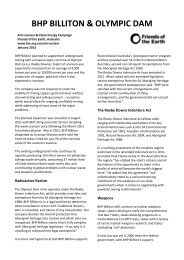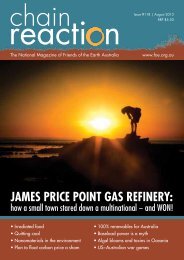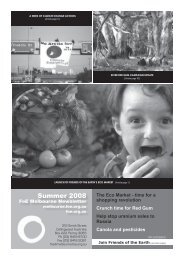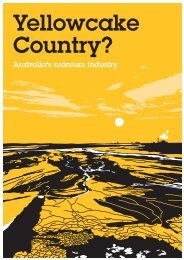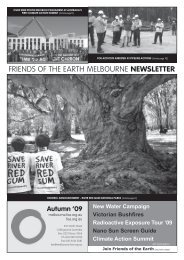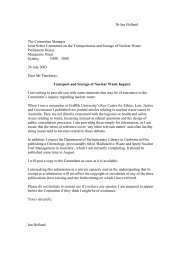Thirty Years of Creative Resistance - Friends of the Earth Australia
Thirty Years of Creative Resistance - Friends of the Earth Australia
Thirty Years of Creative Resistance - Friends of the Earth Australia
You also want an ePaper? Increase the reach of your titles
YUMPU automatically turns print PDFs into web optimized ePapers that Google loves.
<strong>the</strong> anti-uranium collective were becoming<br />
familiar with <strong>the</strong> springs and Roxby; this<br />
was ano<strong>the</strong>r motivation for <strong>the</strong> tour, to<br />
share this experience with o<strong>the</strong>r people in<br />
an organised and constructive way.<br />
The “dry-run” was important because<br />
permission was needed from traditional<br />
owners for camping in <strong>the</strong>ir country and<br />
information on culturally appropriate<br />
behaviour. They also needed to meet<br />
with communities <strong>the</strong>y would be passing<br />
though to organise joint actions against<br />
nuclear activities in <strong>the</strong>ir areas. These<br />
included CRA’s proposed mineral sands<br />
development near Horsham in Victoria and<br />
<strong>the</strong> Rare <strong>Earth</strong> Tailings dump at Port Pirie.<br />
Later tours took in <strong>the</strong> Beverley Uranium<br />
Mine and <strong>the</strong> Honeymoon Project, and<br />
at <strong>the</strong> invitation <strong>of</strong> <strong>the</strong> Kupa Piti Kungka<br />
Tjuta, camping at Ten Mile Creek just out<br />
<strong>of</strong> Coober Pedy. In more recent tours <strong>the</strong><br />
proposal for a low to intermediate level<br />
nuclear waste dump in <strong>the</strong> Woomera area<br />
has also become a focus.<br />
In organising <strong>the</strong> tours we endeavoured<br />
to make <strong>the</strong>m more than just an outback<br />
adventure, we have organised public<br />
meetings on radiation exposure levels<br />
at <strong>the</strong> Roxby Downs Community Centre,<br />
leafleted <strong>the</strong> entire town on workers’<br />
and community health issues, produced<br />
a performance at <strong>the</strong> Woomera Primary<br />
School that involved all <strong>of</strong> <strong>the</strong> students<br />
as well as <strong>the</strong> people on <strong>the</strong> tour, and<br />
organised many stalls and actions with<br />
local environmentalists.<br />
Following a tour in 1996 <strong>the</strong> participants<br />
formed a collective and organised <strong>the</strong><br />
‘Roxstop Action and Music Festival’ in<br />
1997, where over 300 people ga<strong>the</strong>red at<br />
Roxby to protest against <strong>the</strong> expansion<br />
<strong>of</strong> <strong>the</strong> mine. Here <strong>the</strong>y hosted a public<br />
meeting attended by over 120 people with<br />
<strong>the</strong> United States epidemiologist Dr David<br />
Richarson as <strong>the</strong> key note speaker talking<br />
about his work and <strong>the</strong> effects <strong>of</strong> low level<br />
radiation exposure on nuclear workers.<br />
Roxstop also included an exhibition <strong>of</strong><br />
paintings by <strong>the</strong> Melbourne Artist Lyn<br />
Hovey in <strong>the</strong> Roxby Library. After three<br />
days at Roxby <strong>the</strong> protestors moved to<br />
Alberrie Creek on Finnis Springs Station<br />
where a music festival was held over three<br />
nights to celebrate <strong>the</strong> Mound Springs,<br />
while during <strong>the</strong> day <strong>the</strong>re were cultural<br />
...................................................................................................................................................................................................<br />
workshops and tours given by members <strong>of</strong><br />
<strong>the</strong> Arrabunna community including Reg<br />
Dodd and Kevin Buzzacott.<br />
In August 1998 <strong>the</strong> collective that had<br />
organised Roxstop received a fax from<br />
<strong>the</strong> Kupa Piti Kungka Tjuta saying, “We’re<br />
trying hard about this rubbish - <strong>the</strong> radioactive<br />
waste dump. We don’t want that...,.<br />
We want your help! We want you to<br />
come up here to Coober Pedy and have a<br />
meeting with Aboriginal people (and any<br />
whitefellas from here who want to come)”.<br />
In September that year a group <strong>of</strong> over 12<br />
people travelled from Melbourne to Coober<br />
Pedy, held a public meeting on <strong>the</strong> dump<br />
and met with Aboriginal people.<br />
Things did not always rum smoothly, one<br />
year we were stranded on <strong>the</strong> Borefield<br />
Road between <strong>the</strong> Oodnadatta Track and<br />
Roxby Downs with forty people and three<br />
buses for one night when <strong>the</strong> road became<br />
impassable due to rain. Ano<strong>the</strong>r time at<br />
Mambury Creek in <strong>the</strong> sou<strong>the</strong>rn Flinders<br />
Rangers emus raided our camp and<br />
scattered cereal, bread and fruit over <strong>the</strong><br />
campsite while people were in Port Pirie at<br />
a protest. And <strong>the</strong>re have been high-lights:<br />
<strong>the</strong> first time <strong>the</strong> Kungka Tjuta invited us<br />
to Ten Mile Creek just outside Cooper Pedy;<br />
<strong>the</strong> moon rising over Lake Eyre South; <strong>the</strong><br />
leaflet on workers’ heath and <strong>the</strong> effects<br />
<strong>of</strong> exposure to low levels <strong>of</strong> radiation;<br />
protesting outside <strong>the</strong> Woomera Detention<br />
Centre; seeing <strong>the</strong> representatives <strong>of</strong> <strong>the</strong><br />
Honeymoon Uranium Project squirm as<br />
participants asked questions about <strong>the</strong><br />
chemical structure <strong>of</strong> <strong>the</strong> waste solution<br />
to be pumped back into <strong>the</strong> aquifer; and<br />
being warmly greeted by members <strong>of</strong> <strong>the</strong><br />
Adnyamathanha community at Nepabunna<br />
even though we were four hours late.<br />
There have been many great and rewarding<br />
outcomes from <strong>the</strong> Nuclear Exposures<br />
Tours, but what stands out and must be<br />
acknowledged is <strong>the</strong> streng<strong>the</strong>ning <strong>of</strong> close<br />
working relationship between Aboriginal<br />
communities with both <strong>Friends</strong> <strong>of</strong> <strong>the</strong> <strong>Earth</strong><br />
and many individuals who have taken part<br />
in tours. Every person who has gone on<br />
a tour has had an amazing, memorable,<br />
never-to-be-forgotten experience and<br />
many <strong>of</strong> <strong>the</strong> participants from various tours<br />
have made a considerable contribution to<br />
<strong>the</strong> anti-nuclear movement.<br />
FoE 30 <strong>Years</strong> 42



